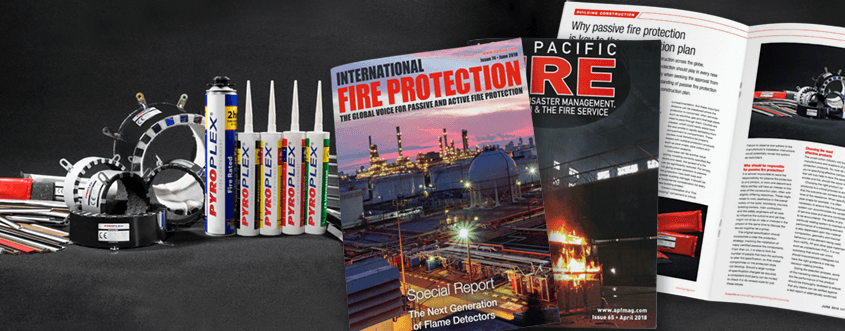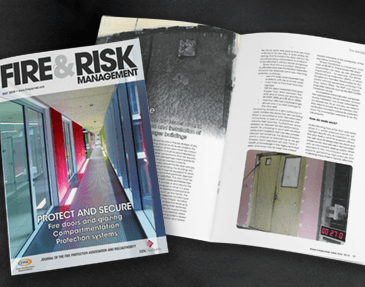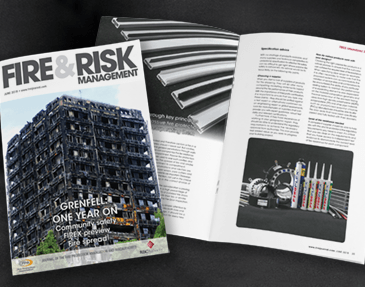
Clarifying the remit of passive fire protection
First things first. Let’s be clear on what passive fire protection actually is. Whilst you might be more familiar with “active” fire safety measures such as alarms, extinguishers and sprinkler systems – which require action to fight the fire when it breaks out – passive measures concern critical components that should be incorporated into the framework of the building, helping to effectively compartment it.
A building can be divided into smaller sections with the use of walls and floors. This is generally termed compartmentalising or compartmentation. But these important divisions can be weakened where fire protection is concerned, when services such as electrics, gas and drainage pipes need to pass through them. Cavities are created, which could easily assist both fire and smoke in rapidly spreading from compartment to compartment. These cavities must therefore be properly sealed with suitable protection products such as pipe wraps, fire pipe collars and fire sealants.
Doorways can be another issue and by installing correctly specified fire doors and seals, the spread of a fire can be significantly reduced. Put simply, not giving proper attention to passive fire protection risks both lives and greater building damage. It should be a fundamental consideration for every new building project.
Correct installation of a “Fire Stopping” component is critical. Failure to observe and adhere to the manufacturer’s installation instructions could potentially render the system as redundant.
Who should be responsible for passive fire protection?
It is almost impossible to issue the responsibility for passive fire protection to one person, or even one department. Many parties will have an interest in this area of the construction plan, often with slightly differing objectives. These might relate to cost, aesthetics or the overall safety of the build. Architects, insurers, building owners, main contractors and fire safety engineers will all seek to influence the outcome and yet they might not all be on-site or involved in the project at the same time to discuss the issues together as a group.
The original specification should incorporate a clear fire protection strategy, involving the installation of many certified passive fire components. From then on, it is wise to limit the number of people that have the authority to alter the specification, so that undue compromise on fire protection does not develop. Should a large number of specification changes be required, a competent third party can be invited to check it in its revised state for just these issues.
Choosing the most effective products
The construction industry will find many manufacturers and suppliers of passive fire protection products. So, how do you know you’re specifying effective components that will truly help to slow the spread of smoke and fire, should the worst happen?
Choosing the right product (or products) is a critical process to ensure that the outcome can achieve the required level of fire resistance. When specifying pipe wraps for example, it is often necessary to ensure that the proposed system can accommodate the variation of service sizes and service combinations to be encountered. The ability of any particular sealing system to maintain the performance of a separating element is also dependent upon the material composition, geometry and thermal behaviour of the element being used, from HDPE, PP and other pipe materials such as unplasticised PVCu. It is not surprising that errors can occur, should inexperienced colleagues not have the right guidance in this key decision-making process.
During the selection process, some of the marketing claims based around the fire performance of the product should be thoroughly reviewed to ensure that any claims can be verified against a test report or alternatively confirmed via an engineering report and/or global assessments.
Working with manufacturers and suppliers that can provide not just expert guidance, but also robust test data coupled with approvals and relevant certifications can pay huge dividends. Suppliers that are used to working with construction companies globally will also be of great value, as they will understand the regulatory requirements to achieve the necessary approval from authorities.
There are a number of industry recognised third-party certification schemes available, covering a wide range of fire stopping and passive fire protection products. Independent third-party certification schemes formally assure performance, quality, reliability and traceability. Recognised by regulatory authorities worldwide, these schemes are an internationally respected mark of fire protection and some of the most authoritative voices in the industry.
Choosing a product that carries the mark of a reputable third-party certification body gives assurances as to the overall performance and effectiveness of that product. Using correctly installed certificated products provides a powerful demonstration that due diligences have been served.
Correct installation will save lives
Not all contractors have the right knowledge and skillset to install passive fire protection products. Even if you have correctly specified the product, a poor installation will, at best, give limited results. At worst, it risks lives and a greater level of damage to the building. Talk to your manufacturers early in the building programme, as they will be able to recommend specialist installers or provide education and training for your existing team to ensure correct installation of their products at the right time in the build.
The importance of monitoring protection after completion
You might be forgiven for thinking that passive fire protection is only the concern of those responsible for the construction of a new building. This is not the case. Commercial and residential buildings are never static. Let’s take the example of a business that installs a new computer network throughout its offices. This would most likely require cables to pass through walls and floors. Going back to the key principle of compartmentation, this immediately breaches the fire-resistance of the various compartments, opening up the risk of accelerated fire and smoke spread. Furthermore, the contractor that installed the new computer network might well consider himself entirely separate to the concern of passive fire protection and have limited knowledge on the impact of their actions.
This example prompts the question of who should be responsible for passive fire protection during the working life of the building and who should be deciding upon the right choice of contractors to carry out additional works? The answer to this important question will differ by building, but it is a critical question to address.
Good practice is to inspect the building at regular intervals, identify any compromises on the original compartmentation due to modifications and address the problems promptly. With such dire consequences, should this not be achieved, it’s easy to see the importance of such actions.
Where to seek help
Understandably, everyone in the construction industry cannot be an expert on passive fire protection and have relevant, regional knowledge to assist in an effective outcome. It is important therefore, to work closely with manufacturers and suppliers that can offer that service to you. In doing so, you will be able to develop a strategy that will meet the approval of the authorities first time and minimise delays due to unforeseen problems during the build. Plus, the completed building will be equipped to slow the spread of fire, leading to a safe evacuation and less costly damage for the owner.
Independent organisations such as the Association for Specialist Fire Protection (ASFP) can also provide a wealth of valuable information for specifiers and installers around the issue of fire protection. The Association strives to promote excellence in the design and installation of fire protection products through high quality standards and unrivalled technical expertise, by fostering the education and training of all those involved in the development, specification and use of ‘built-in’ passive fire protection. The Association and its membership (which includes Pyroplex) works closely with international standard setting bodies, providing significant input into many guidance documents and standards that have been developed to support and guide the industry, promoting high standards of specification and installation.
Pyroplex will be exhibiting at Firex International at Excel London from 19th to 21st June 2018 (Stand no. A410). The exhibition promotes third party approved fire safety products and welcomes over 17,000 fire professionals from across the globe to share best practice and remain up to date on changes in legislation.
- Fire-safe building - 21st August 2018
- How to incorporate certified passive fire protection for a safer build - 18th June 2018
- Why Passive Fire Protection is Key to the Construction Plan - 12th June 2018



